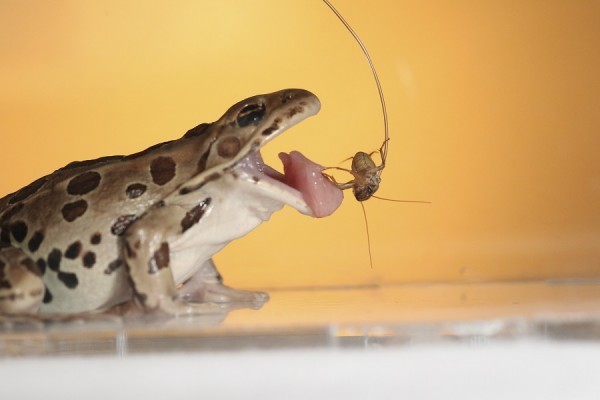By Ana Verayo, | February 03, 2017

A northern leopard frog catches a cricket
Scientists have now determined what makes a frog's tongue so sticky, capturing insect prey with just a snap of its long, flexible and uniquely adhesive tongue.
In this new study, frog saliva can apparently switch its liquid property to thin and watery in order to strike on flies and other insect prey and it can also become thick, mucus-y sticky so that the insect can no longer escape this bizarre whip trap.
Like Us on Facebook
According to first author of the study, Alexis Noel from the Georgia Institute of Technology, Atlanta, frogs' saliva can seep easily when it successfully hits its target and immediately becomes thick as it retracts, making this an incredible process.
This saliva consistency is triggered by "shearing forces" or forces that are working in opposite or unaligned directions, which is called a non-Newtonian fluid. One of the more popular examples of non-Newtonian fluids is custard. Custard can be easily eaten and you can immerse your hand into a bowl of it but once you punch it, it becomes a solid state.
In frog saliva, this "shear thinning fluid" is the opposite of this phenomenon. Frog spit remains stationary on a surface, revealing a thick, mucus like texture. However, when the frog snaps and whips out its tongue at high speeds, this shearing force instantly thins out the saliva in order to wrap around the insect's body and all its crevices.
Noel adds, when the tongue snaps back, the saliva becomes more viscous, transforming into something thicker than honey and completely gripping the insect, covering it in something similar to glue.
By analyzing saliva samples taken from 18 frogs, scientists were able to identify the exact shear rate when this viscosity lessens or thickens. The team used a rheometer which is a highly sensitive instrument that can measure fluid properties.
Frog saliva apparently possesses long chain proteins that makes it thick and sticky like mucus as opposed to human spit. In addition, frog tongues are so soft, similar to brain tissue or 10 times softer than a human tongue, which can enhance this viscosity.
By studying frog saliva properties, researchers say that its practical applications can involve reversible adhesives that can be utilized in drones with artificial frog tongues to capture flying objects. This new study is published in the Journal of the Royal Society Interface.
-
Use of Coronavirus Pandemic Drones Raises Privacy Concerns: Drones Spread Fear, Local Officials Say

-
Coronavirus Hampers The Delivery Of Lockheed Martin F-35 Stealth Fighters For 2020

-
Instagram Speeds Up Plans to Add Account Memorialization Feature Due to COVID-19 Deaths

-
NASA: Perseverance Plans to Bring 'Mars Rock' to Earth in 2031

-
600 Dead And 3,000 In The Hospital as Iranians Believed Drinking High-Concentrations of Alcohol Can Cure The Coronavirus

-
600 Dead And 3,000 In The Hospital as Iranians Believed Drinking High-Concentrations of Alcohol Can Cure The Coronavirus

-
COVID-19: Doctors, Nurses Use Virtual Reality to Learn New Skills in Treating Coronavirus Patients







